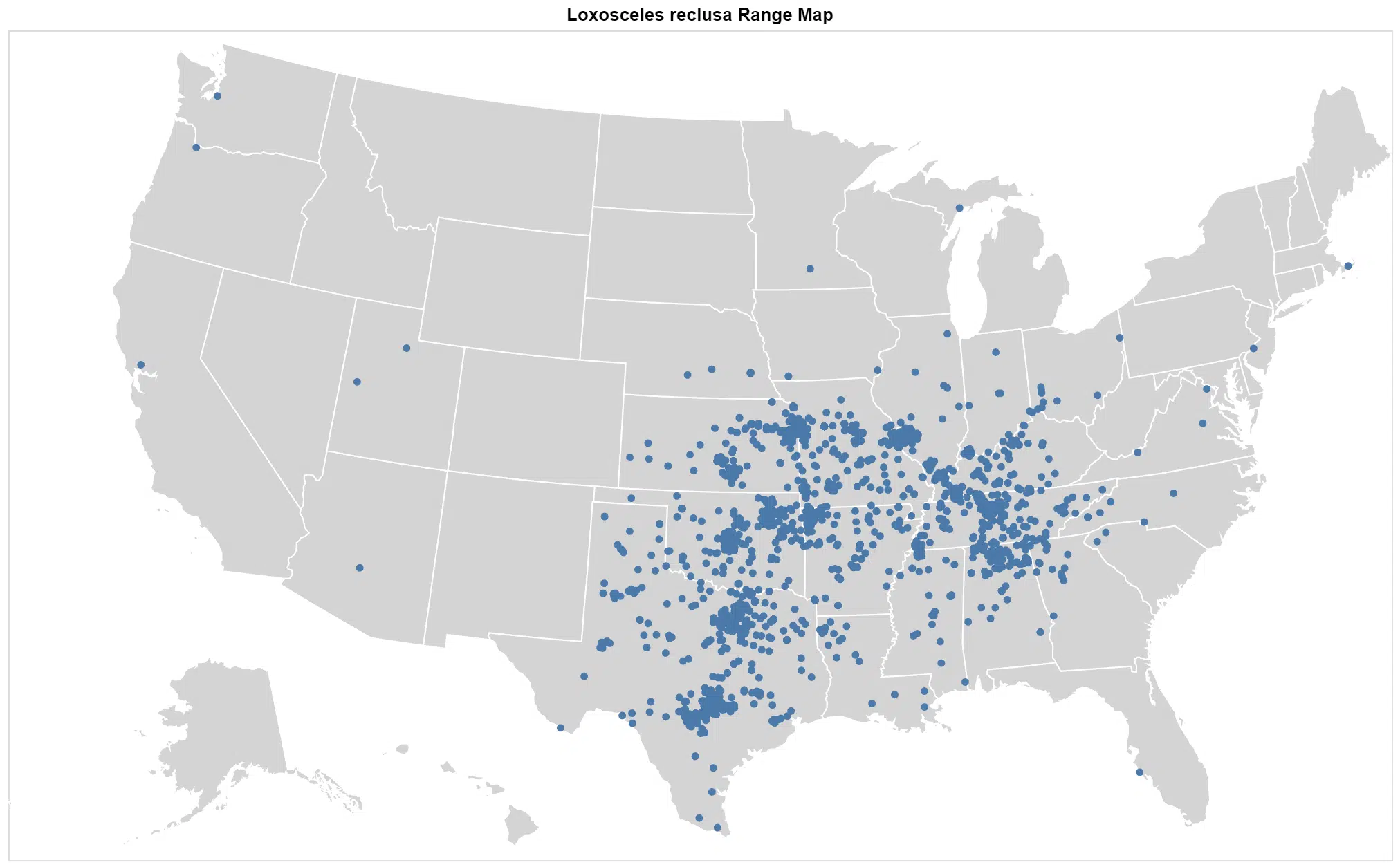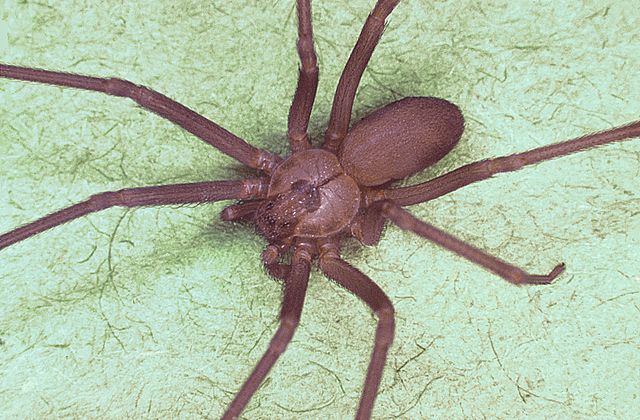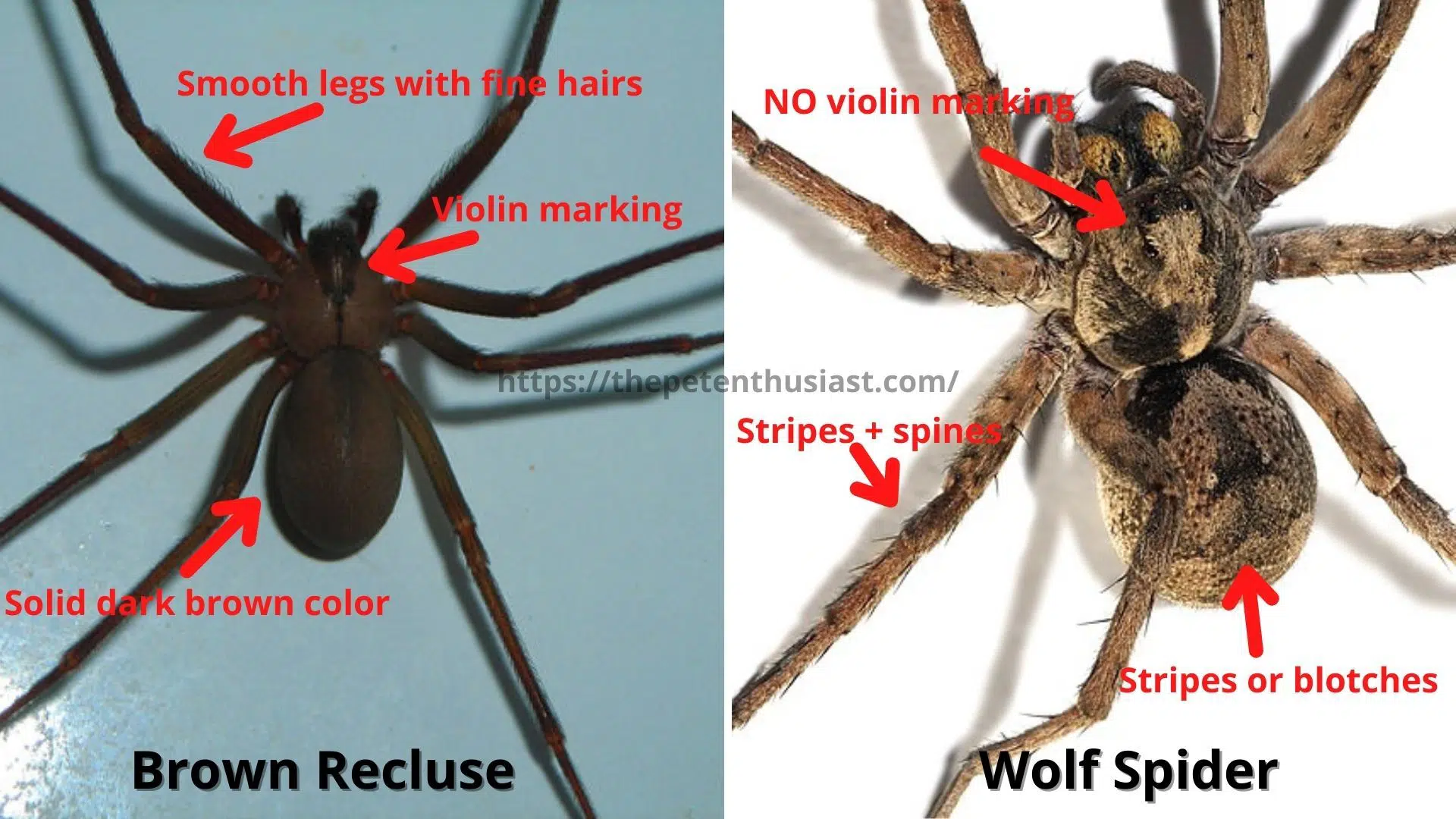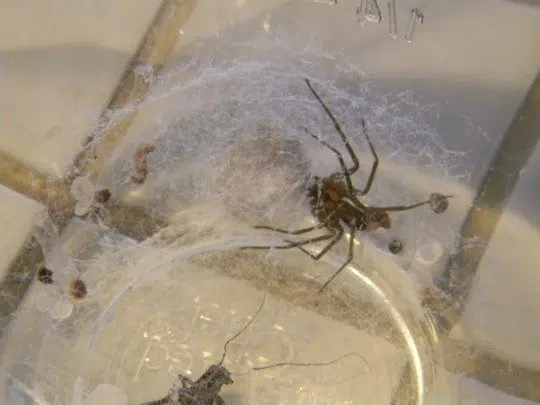If you have seen a brown spider in your home or yard, you may be wondering what type of spider it is. Brown spiders can be a venomous brown recluse, it could also be a wolf spider.
Do you know the difference between the two? Many people can’t. The good news is there are a few easy ways to tell the two apart.
Table of Contents
Why Are Brown Recluse Spiders Often Confused With Wolf Spiders?
Brown recluse spiders are venomous spiders with a dark violin marking on their abdomens with the base of the violin facing towards the head with the neck of the violin towards the rear. These spiders are not that big, are hairless and brown in color.
There are many species of wolf spiders you may encounter in your yard or home. They are also brown and often confused with the brown recluse, but they don’t have the violin marking on their backs.
They are larger than the brown recluse, but when you only get a quick look, it’s not always easy to tell the two apart.
The brown recluse and wolf spider are often confused due to their similar appearance and the fact they are both brown.
Many people only get a quick look, which makes it hard to distinguish between the two.
Brown Recluse vs Wolf Spider: How to Tell The Differences
Here are some simple ways to tell a brown recluse apart from a wolf spider.
Location
Brown Recluse

Brown recluse spiders are only found I the Southern States of North America and are not found anywhere else in the country.
Wolf Spiders
Wolf spiders can be found throughout North America. There are many species that can be found throughout the country.
Habitat
Brown Recluse
Brown recluse spiders are often found living outdoors in woodpiles and debris. Its not uncommon to find hundreds or thousands of these spiders in one area.
When they do come indoors, they prefer cardboard, as it is similar to rotting tree bark.
Wolf Spiders
Wolf spiders can be found in a range of habitats from woodlands and inland shrublands to coastal forests and alpine meadows. Some species prefer suburban gardens.
They may wander indoors hunting for their next meal.
Hunting Time
Brown Recluse
The brown recluse spider is nocturnal, hiding during the day and hunting at night. They are secretive, so chances are you will not encounter one.
Wolf Spiders
Because there are many wolf spider species in North America, you may come across some wolf spiders during the day and at night.
Some will actively hunt at night, while others will actively hunt during daylight.
Size
Brown Recluse

An adult brown recluse will grow to around a quarter or half an inch in body length.
Wolf Spiders
Wolf spiders range in size, they can grow from half an inch to over two inches. They are large and hairy, which makes them seem scarier than they are.
Eyes
Brown Recluse

The brown recluse is not the same as other spiders when it comes to their eyes.
These spiders only have six eyes, instead of the eight that most spiders have. Their eyes are small and black. Their eyes are not easy to see.
Wolf Spiders

All the wolf spider species have eight dark eyes which are arranged around the cephalothorax (head space).
They have two large reflective eyes at the top of the head, two that are at the front, and four small eyes in a row, just above the mouth.
Reflective tissue is in the four large eyes, which can be seen if you flash a light over the spider.
Cephalothorax
Brown Recluse

The brown recluse has a violin-shaped marking on the top of the cephalothorax, which is the identifying feature of this venomous spider. As a result, they are often referred to as the violin spider or fiddle-back spider.
The violin marking can vary in intensity, based on the spider’s age. The older the spider, the darker the violin shape is.
The violin points towards the bulb-shaped abdomen, though it can be easy to misinterpret the marking.
Wolf Spiders
Wolf spiders cephalothorax can be brown, gray, and yellow, usually with black stripes. There is no violin marking on the wolf spider.
Abdomen
Brown Recluse
The brown recluse spider has a bulb-shaped abdomen that can be a light tan to a dark brown. There is no banding, striping, or mottling on the abdomen.
If you see a spider that looks similar but has a stripe or band on the abdomen, then it is not a brown recluse.
Wolf Spiders
Wolf spiders rely on camouflage to help them blend into their surroundings, therefore their abdomen can range from brown to black or orange to gray. Some have all the colors.
They have some striping or blotching on the abdomen, which you will not see in a brown recluse. The underside is a light gray., black, cream, or salmon pin with white or black markings.
They are not flashy in appearance with their coloration based on their habitat.

Legs
Brown Recluse
The brown recluse has what is known as slanted legs. If you look at the spider from the side, you will see the body sitting low to the ground with the legs angled to a point.
There are no spines on the legs, unlike many other spiders, the legs are completely smooth. They are also a solid color without any stripes or banding.
If the spider doesn’t have slanted legs, then it is not a brown recluse.
Wolf Spiders
Wolf spiders have hooks on the end of their legs, which helps them grip and hold when climbing and running.
The two front legs are larger than the others, which enables them to grasp onto prey.
They have thick and robust legs, usually marked in a striped pattern.
Activity
Brown Recluse
The brown recluse is a nocturnal spider that is active at night. During the day they remain hidden within the debris and structures they have chosen they build their retreats on wooden surfaces, including cardboard boxes, wooden furniture, and the voids of walls.
They are more active in the warmer months, peaking between March and October.
Wolf Spiders
Wolf spiders can be active during the day or night, depending on the species. They are active hunters and are usually seen hunting for their next meal.
They often make their way into homes in the fall, when temperatures start to drop.
Web
Brown Recluse
The brown recluse is similar to other spiders, building webs from silk, which is released from spinnerets.
The strands are off-white in color and usually seen in dry and dark areas, such as basements, attics, cellars, ductwork, closets, and crawlspaces.
Unlike other spiders, the silk of the brown recluse is flat and thin.

Wolf Spiders
Wolf spiders are fast with the majority of wolf spiders not spinning webs at all. They prefer to chase and pounce on their prey.
They spend most of their time on the ground, roaming around to hunt for their next meal.
Jumping
Brown Recluse
While the brown recluse can jump, they only do so to escape. They will jump if touched but their jump is similar to a horizontal lunge rather than jumping off a surface.
Wolf Spiders
Wolf spiders will often jump when they are hunting for prey. The distance of the jump is based on the species of wolf spider.
Though their jumps can be impressive, they are not prone to jumping onto humans.
Egg Sac And Spiderlings
Brown Recluse
The female brown recluse will deposit up to fifty eggs in a carefully woven silk egg case, which is off-white in color with a loosely woven outer covering.
Each sac can contain up to three hundred eggs, which hatch within thirty-nine days.
The spiderlings remain inside the egg sac until they have had their first molt, after which they come out to fend for themselves.
Wolf Spiders

The female wolf spider will deposit up to one thousand eggs into her egg sac. They protect the eggs by creating a silk bed and covering it with a blanket.
She guards the egg sac until the spiderlings are ready to hatch, at which time the female will rip open the egg sac to release the spiderlings.
They stay with the female for a few weeks, living on her body until they are ready to fend for themselves.
This is why you should never stamp on a wolf spider, as it can release a thousand baby wolf spiders, which can infest your home.

Bite
Brown Recluse
Brown recluse spiders are venomous and their venom can destroy tissue, nerves, and blood vessels, causing the skin tissue to die.
They have small fangs, so a bite from one of these spiders is completely harmless, though you may see a red and tender area around three to eight hours after the bite. The irritation will get worse over the next few hours, causing burning.

Some people develop what is known as a necrotic lesion, which looks like a dry patch of skin, maybe with a blue patch or a red lesion with a pale center. There is a central blister.
After three to five days, you can see the bite reducing if the spider injected a minimal amount of venom and you are strong and healthy. Other people may notice the wound, expanding as the venom spreads.
After the first week to the second week after being bitten by a brown recluse, you can see the bite growing by a few inches. The venom usually starts breaking down the skin at this time. This type of wound may last for months.
After three weeks, the bite should heal. For those with severe bites, this is the time where the wound develops dead tissue, which is black, thick scabs covering the wound.

Most brown recluse bites heal within 3 months. If it doesn’t heal by this time, then it is probably not a brown recluse bite.
Some people have a bad reaction to a brown recluse bite, usually in those with compromised immune systems, such as children and the elderly. You may experience chills, fever, rash, vomiting, and dizziness.
If you experience any of these symptoms after being bitten, seek immediate medical attention.
Wolf Spiders
Wolf spiders are not aggressive, though they will bite if provoked. They inject a venom that causes mild pain, itching, and swelling. They are considered harmless, but their bites can be painful.
The good news is that they are not deadly, but they will and can bite, giving uncomfortable symptoms.
Some people have an allergic reaction to wolf spider venom, so if your symptoms worsen or you feel your throat and face swelling, seek medical attention.
The bite from a wolf spider looks the same as any other bug bite with a red itchy bump, which is swollen. It should go away in a few days.
Seek immediate medical attention if you see a red line extending from the bite, which is a sign of blood infection, or the bite increases in size, you experience problems breathing or you get dizzy.
Ballooning
Ballooning is a behavior used by a spider that enables them to get airborne to move locations.
The spider climbs as high as it can, standing on raised legs with the abdomen pointed forwards. It releases silk strands into the air, which form a triangular-shaped parachute, carrying the spider with the wind.
The static electric field of the earth also provides lift in windless conditions.
The brown recluse does not balloon, which is why they are only found in the southern states.
Wolf spiders are known to balloon. It is usually spiderlings that use this method to disperse aerially using their silks, which is why they are common throughout the country.
What To Do When You See A Brown Recluse Or Wolf Spider
Brown Recluse
If you find a brown recluse in your home, you should spray it with a pesticide and keep well clear to reduce the risk of being bitten.
Only capture it if you feel confident in doing so. You should wear thick gloves, placing a jar over the top of the spider, and sliding something underneath to reduce the risk of the spider escaping.
Turn over the jar, keeping the board or paper in place to contain the spider, you can then release it outdoors.
Wolf Spiders
Wolf spiders usually come into the home in search of food or a mate, therefore the best option is to carefully trap the spider using a jar or container and paper, releasing it outside.
If you notice a serious infestation, then it’s recommended you call the local pest control for further assistance.
What To Do When You Are Bitten
Brown Recluse
If you think it was a brown recluse that bit you, wash the bite area with soap and water before applying antibiotic cream.
Use ice to reduce swelling and take over the counter pain medication. If you notice severe symptoms, visit your doctor or ER immediately.
Wolf Spiders
A wolf spider bite can be painful and itchy, so use an ice pack on the bite area for ten minutes every hour.
Elevate the bite area as much as possible to help reduce swelling.
Take an antihistamine, which can help with the itching. Clean the area with soap and water, which can help reduce the risk of infection.
Watch for any allergic reactions to the venom and seek medical attention if you start experiencing breathing problems or your face and throat start to swell.
How To Prevent Brown Recluse And Wolf Spiders
The brown recluse will look for shelter and hiding places. There are a few things you can do to prevent brown recluse spiders from making their home in your house. These include:
- Eliminate any favorable conditions, remove any debris and boxes that could be turned into a perfect brown recluse retreat
- Clean and dust regularly, vacuum and dust as often as possible.
- Use insecticide sprays or a vinegar spray on baseboards, corners, under furniture, attics, and basements.
- Repair any cracks and gaps outside your home, making it harder for these spiders to make their way into your home.
- Use a flashlight and wear gloves and long sleeves when inspecting. The flashlight can help you look in hidden corners.
- They are often found in cluttered basements and closets, dark recesses, old shoes, boxes, furniture, sheds, and more. Look for cobwebs in these areas.
- Move your woodpile as far from the home as possible, as they love sheltered areas such as pile so frocks, logs, stone, and woodpiles.
Wolf spiders are often found in homes when searching for food or a mate, though they may be common in your yard. There are some things you can do to prevent them, these include:
- Keep your lawn and landscaping well maintained
- Trim any bushes and tree branches away from the home, keeping a five-foot distance
- Use a broom to remove any spider webs
- Fill in any gaps, cracks, and holes in the home exterior
- Ensure your window and door screens are in good condition and use them.
- Add door sweeps under your exterior doors
- Inspect your weather stripping and repair any damage
- Clean the home weekly
- Use tight-fitting lids to your trash cans
- Feed pets inside and remove bowls as soon as they are finished
- Do not use exterior night lights, as this attracts insects, which in turn can attract a hungry hunting wolf spider.
Summary
Because wolf spiders do make their way into homes from time to time and they are brown in color, they are often mistaken as brown recluses.
A spider in the home that is fast, dark, and on the floor is more likely to be a wolf spider than a brown recluse. Brown recluse spiders are secretive and nocturnal and will seldom be seen in the open.
Taking the time to learn the differences between the two can help you quickly identify if you have seen a brown recluse or wolf spider.
Further Reading: